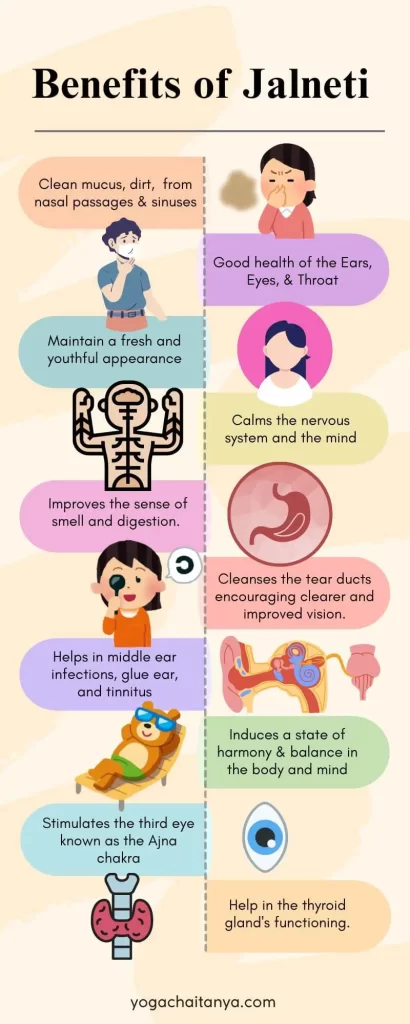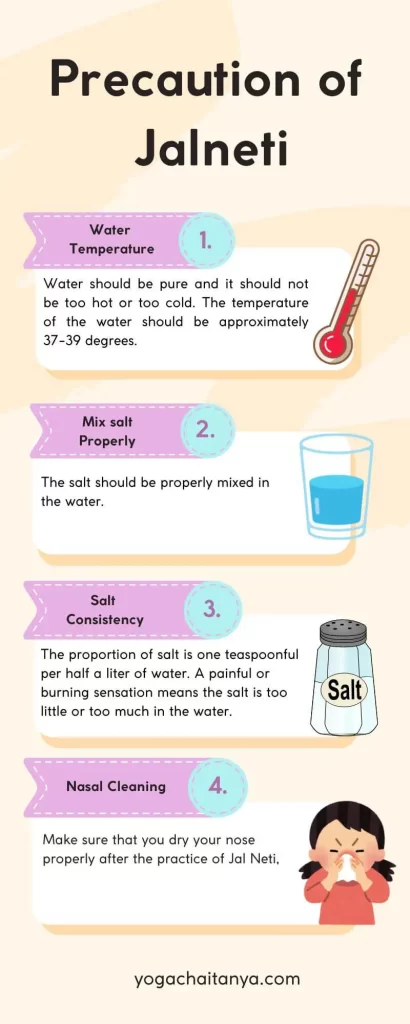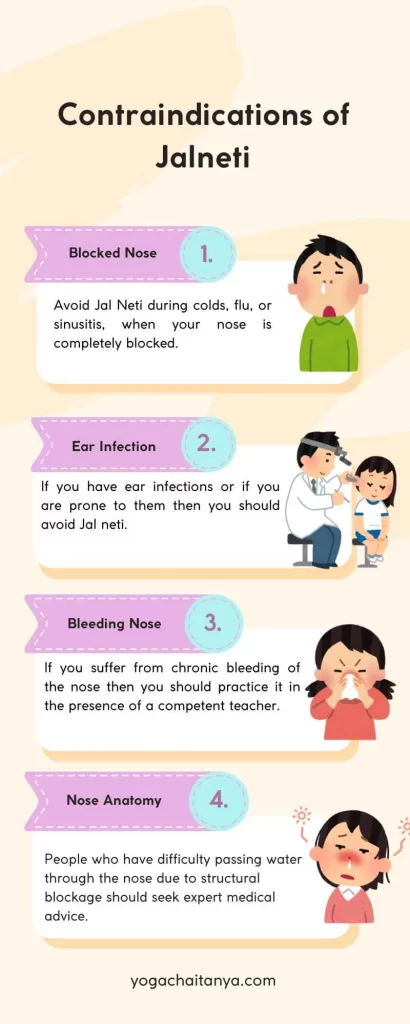The Ultimate Guide to Jalneti: Your Path to Wellness and Beauty!
-
Written By: Sukhvinder Singh (Chaitanya)
- Published On:
- Last Updated: December 5, 2024
Do you want a fresh and youthful appearance and better eyesight?
Do you want to get rid of seasonal allergies, sinus issues, and ear and throat issues?
In this blog, I will introduce you to a cleansing technique known as Jalneti. Further, we will explore how to do it easily, its miraculous benefits, and the safety measures you must take care of before doing it.
In addition to this, I will give some bonus tips on Jal neti (Nasal cleansing) in this blog.
This is the most comprehensive guide to Jal neti ever. In this guide, you will learn everything you need to know about the practice and implementation of Jal Neti (Nasal cleansing) in daily life.
By regular practice of Jal Neti, many people have healed their physical, mental, and emotional problems. Jal Neti will help you enhance the quality of your life.
As a beginner or an advanced yoga practitioner, you may have questions or difficulties implementing Jal Neti. This “Ultimate Guide to Jalneti: Your Path to Wellness and Beauty!” will provide in-depth knowledge of the topic. Here you will learn:
- Introduction to Jal Neti
- Historical Background of Jal Neti
- Understanding the Science Behind Jal Neti
- Benefits of Jalneti
- Precaution of Jalneti
- Contraindications of Jalneti
- How to do Jal Neti?
- Variations of Jalneti
- Integrating Jal Neti into Your Yoga Practice
- Jal Neti Routine
- Research and Studies on Jal Neti
- FAQs about Jal Neti
Table of Contents
Introduction to Jal Neti
All of us start a day by brushing our teeth and taking a shower cleaning our body and then we move towards the daily life routine or work.
We always clean our body from the outside but, what about the internal cleaning of the body?
In yoga, we have different cleansing techniques that cleanse the different organs and systems of the body so that we can stay healthy and fit. These cleansing techniques are known as shatkarmas.
One of these shatkarma is neti which is used for the cleansing nose.
Neti is done by using a cotton thread, or water. If we use a cotton thread then it is known as sutra neti but when we use water for cleansing then it is known as Jal neti. In this blog, we will talk about Jal neti.
The Sanskrit word “JAL” means “water” and “NETI” means “to guide”. JAL NETI is the practice of guiding water through the nasal passages to cleanse them.
It is a natural technique used by yogis to stay healthy and disease-free. Its most important use is to increase the prana flow through the breath for yogic practices.
Historical Background of Jal Neti
The roots of Jal Neti are deeply embedded in the ancient tradition of yoga and Ayurveda of India, dating back thousands of years. Jal Neti was developed as a part of Hatha Yoga practices to purify the body and prepare it for deeper spiritual endeavors.
References to nasal cleansing can also be found in ancient Indian texts like the Hatha Yoga Pradipika and the Shiva Samhita.
Understanding the Science Behind Jal Neti
Our human nose is involved in several important bodily functions:
- It Allows air to enter the body.
- It filters and cleans the air to remove particles and allergens.
- It provides a sense of smell.
- It warms and moistens air so that air can move comfortably into the respiratory system.
In addition to this, our nose is connected to the sinuses, eyes, ears, throat, and the way to the lower respiratory system.
So nasal hygiene is very important and we should never ignore it.
Lack of nasal hygiene can lead to many conditions like sinusitis, migraine, allergies, snoring, and asthma.
The Jal neti works on the principle of nasal irrigation. In Jalneti we gently pour a saline solution through one nostril and expel it through the other. This process flushes out impurities, allergens, and excess mucus, promoting clear breathing and sinus health.
Jal neti offers profound physiological benefits beyond the cleansing process. It moisturizes the nasal mucosa and stimulates the nasal cilia, it enhances the body’s natural defense mechanisms against respiratory infections and allergies.
Let’s talk about some of the benefits of Jal neti that will amaze you and drive you toward this cleansing technique.
Benefits of Jalneti
1) The practice of Jal neti removes mucus, dirt, and pollution from the nasal passages and sinuses, allowing air to flow without obstruction. It helps prevent and manage respiratory tract diseases.
2) It helps to maintain good health of the ears, eyes, and throat.
3) The regular practice of Jal neti alleviates upper respiratory issues like sore throats, tonsils, and dry coughs.
4) Jal neti helps to relieve muscular tension in the face and it helps the practitioner to maintain a fresh and youthful appearance.
5) It has a calming and soothing influence on the brain. Jal neti helps to alleviate anger, anxiety, and depression. Further, it removes drowsiness and makes the head feel light and fresh. It also calms the nervous system and the mind, relieving stress and bringing clarity to the mind.
6) Jal neti stimulates and improves the sensitivity of the olfactory nerves thereby, improving the sense of smell and digestion.
Now you might be wondering how the sense of smell can improve digestion. The smell of food induces a variety of physiological processes in our bodies. The production of saliva and digestive enzymes is stimulated before the actual food enters the mouth which improves the digestion process.
7) Jal neti practice cleanses the tear ducts encouraging clearer and improved vision.
8) Regular practice of Jal neti is beneficial for middle ear infections, glue ear, and tinnitus, further, it helps to manage seasonal allergies, snoring, and sleep apnea.
9) After the practice of Jal neti a balance is established between the right and left nostrils and the corresponding left and right brain hemispheres, inducing a state of harmony and balance throughout the body and mind.
10) It stimulates the third eye known as the Ajna chakra which helps in awakening higher states of meditation. It will help you improve the quality of your meditation.
11) Hypothyroidism is a condition that happens due to thyroid hormone deficiency. Regular practice of yoga asanas, pranayama, and Jalneti regularly may stimulate adequate blood flow to the thyroid gland. This will offer nourishment to the cells and may help in the thyroid gland’s functioning.
Before proceeding towards the practice of Jal neti let’s discuss the most important thing i.e. Precautions & contraindications that must be taken care of.

Precaution of Jalneti
1) Water should be pure and it should not be too hot or too cold. The temperature of the water should be approximately 37-39 degrees.
2) The salt should be properly mixed in the water.
3) The proportion of salt is one teaspoonful per half a liter of water. If you experience a painful or burning sensation that means the salt is too little or too much in the water.
4) Make sure that you dry your nose properly after the practice of Jal Neti, otherwise, the nasal passages and sinuses may become irritated and manifest the symptoms of a cold.

Contraindications of Jalneti
1) Avoid Jal Neti during colds, flu, or sinusitis, when your nose is completely blocked.
2) If you have ear infections or if you are prone to them then you should avoid Jal neti.
3) If you suffer from chronic bleeding of the nose then you should practice it in the presence of a competent teacher.
4) People who have difficulty passing water through the nose due to structural blockage should seek expert medical advice.

How to do Jal Neti?
Jal Neti Stage 1:
- For Jal Neti we need a special neti pot. This pot may be made of plastic, pottery, brass, copper, or any other metal which does not contaminate the water.
- This pot should have a nozzle on the end which fits comfortably into the nostril so that the water does not leak out.
- The water should be pure, at a body temperature of approximately 37-39 Degrees C, and thoroughly mixed with salt in the proportion of one teaspoonful per half a liter of water.
- A painful or burning sensation is an indication of too little or too much salt in the water. You can do Jal Neti while standing or in the squatting position.
- Fill the neti pot with the prepared salt water. Stand with your legs hip-width apart, body weight evenly distributed between the feet. Lean forward and tilt the head to one side.
- Breathe through the mouth. Now gently insert the nozzle into one of the nostrils. Do not apply any force. The nozzle should press firmly against the side of the nostril so that no water leakage occurs.
- Tilt the neti pot in such a way that water runs into the nostril and not down the face. Keep your mouth open. Raising the elbow of the hand which holds the neti pot will help to adjust the body position so that the water flows out through the other nostril.
- When half the water has passed through the nostrils, remove the nozzle from the nostril, move your head back to the center, and let the water run out of the nose. Remove any mucus from the nose by blowing gently.
- Now tilt your head to the opposite side and repeat the process, by placing the nozzle of the neti pot (Lota) in the other nostril. After completing this process, the nostrils must be thoroughly dried.

Jal Neti Stage 2: Drying the nostrils
- Stand erect. Now close your right nostril with the right thumb and breathe in and out through the left nostril 10 times quickly, as in kapalbhati pranayama.
- Repeat through the right nostril, with the left nostril closed. Perform once more through both nostrils.
- Then, bend forward from the waist so that the trunk is horizontal parallel to the floor. Repeat the same nostril drying process as described above, by tilting the head to the right, and closing the right nostril.
- Repeat, by tilting the head to the left and closing the left nostril. Finally, repeat the process by moving the head to the center, and breathing through both nostrils. This step helps to drain trapped water from the sinus cavities.
- Stand erect with the feet hip-width apart. Now close your right nostril and exhale forcefully while bending forward rapidly from the waist. Inhale normally while returning to the upright position. Repeat 5 times.
- Repeat with the right nostril open and then with both nostrils open. Do not blow the nose too hard as the remaining water may be pushed into the ears.
- At last, perform Shashankasana (Hare pose) for several minutes to allow the drainage of any remaining water.
- For doing Shashankasana come on all fours, with your knees below the hips, arms shoulder width apart, wrist, elbow, and shoulders in one line. Now roll your hips down onto the heels, feet flat, forehead touching the floor, arms extended forward, palms facing down.
Variations for Jalneti
You can use some other liquids also, instead of water for the practice of Jal neti. These liquids can be warm milk, warm clarified butter, or ghee.
If we use warm milk for neti then it is called Dugdh neti.
In case of warm clarified butter or ghee, it is called Ghrita neti. If you use oil instead of ghee, then it must be natural and without any chemicals.
Each liquid has a different benefit. Please note none of these variations should be attempted unless instructed by a competent teacher.
Integrating Jal Neti into Your Yoga Practice
If you want to experience the benefits of Jal Neti, try to integrate it into your daily or weekly yoga routine. Start with a gentle practice to familiarize yourself with the technique, as you become comfortable, gradually increasing the frequency and duration.
Incorporate Jal Neti into your pre-practice ritual to prepare your body and mind for deeper yogic exploration. Jal neti should be practiced in the morning before asanas and pranayamas. However, if necessary, it may be performed at any time, except after meals.
Jal Neti Routine
Pre-Yoga Cleansing: You should perform Jal Neti before your yoga practice to clear your nasal passages. It will enhance breath awareness. You will breathe more freely and deeply during the asanas (yoga postures) and pranayama (breathwork) practice, facilitating more prana flow in the body.
Daily Maintenance: You can incorporate Jal Neti into your daily self-care routine as a preventive measure to maintain optimal respiratory health and overall well-being. Make sure you are consistent, to experience the benefits. Make it a habit to prioritize nasal hygiene as part of your holistic wellness practice.
Research and Studies on Jal Neti
A study published by Research Gate in the Journal of Current Medical Research and Opinion “Neti Kriya Enhances the Nasal Functions ” demonstrated the effect of Jal Neti.
Research studies Findings were: Jal neti removes the excessive mucous emission, reduces tenderness, and diminishes bronchial allergic reaction. Regular practice of neti kriya makes sure to revitalize the complete nose region therefore avoiding a lot of illness in this part of the body.
Cleansing practice neti kriya makes the brain cells new and revive, recovers the purpose of the slash canal and olfactory area of the brain, and helps with sleeplessness.
It boosts conflict to incursion by bacteria. Neti practice greatly assists in balancing the airflow of the two nostrils. It prevents and manages colds, coughs, and sneezing.
Remove all the complications and facilitate relieving of headache and migraine. The practice of neti is good for boosting memory.
In conclusion, this yogic kriya practice involves cleaning up the nasal passages and the throat. Neti cleans the impurities of nostrils and delicate membranes, helps to provide more oxygen to the whole body improves the functions of nostrils and brain cells, has a great influence on psycho-spiritual health, and removes snoring at night.
Frequently Asked Questions about Jal Neti
Is Jal Neti safe for children?
Yes, Jal Neti is safe for children. It’s better if they perform it under adult supervision. However, it is recommended to use a small Neti pot and a lower concentration of saline solution.
Can Jal Neti cause any side effects?
Jal Neti is generally safe. However, using contaminated water or improper technique may lead to mild side effects like nasal irritation or discomfort.
How often should I practice Jal Neti?
You can practice Jal Neti daily or on alternate days to experience its benefits. However, the frequency can vary depending on individual needs and preferences.
Can Jal Neti help with snoring?
Yes, Jal Neti can help reduce snoring by clearing the nasal passages and promoting better airflow. If you have nasal congestion or blockages you must try it.
Is Jal Neti recommended for pregnant women?
Pregnant women can safely practice Jal Neti with caution. However, it is advisable to consult a healthcare provider before starting any new practices during pregnancy.
Can jal neti help with allergies?
Yes, jal neti can provide relief from allergy symptoms by flushing out allergens and irritants from the nasal passages. Further, reducing congestion and inflammation.
Can Jal neti alleviate headaches?
Jal neti may help you alleviate headaches associated with sinus congestion and tension. It promotes drainage and relieving pressure in the nasal passages.
Is it normal to experience mild discomfort during jal neti?
Yes, some individuals may experience mild discomfort or a sensation of water retention during jal neti, during the first few times. But it resolves with practice and proper technique.
Can I use tap water for Jal neti?
Generally, it is advisable to use distilled or boiled water for jal neti to minimize the risk of contamination and infection. But if the quality of tap water is good then you can use it for jal neti.
Conclusion
Incorporating Jal Neti into your daily life can have transformative effects on your well-being. Its a way to enhance your yoga practice and promote holistic well-being.
By incorporating this ancient cleansing technique into your routine, you can experience improvement in respiratory health, sinus relief, mental clarity, and a heightened sense of overall vitality.
So, try incorporating Jal Neti into your daily yoga practice and see the results.
I hope you liked this post. Now I would like to hear from you. What did you think of today’s post?
Or maybe if you have a question about Jal Neti. Let me know by leaving a comment below.
Practice Jal Neti regularly to cleanse your nostrils and keep your mind relax and senses sharp. Yin yoga is also a effective tool to let go stress, tension, and insomnia. Learn Yin yoga and different meditation techniques in detail.
Join our 200 Hour Yin Yoga and Meditation Teacher Training Course. It is carefully designed using an integrated approach to yin yoga, active and passive meditations, Pranayamas, mudras, and other alternative healing practices. Lear to design and teach Yin yoga sessions for healing.
Yoga Chaitanya International Institute is one of the leading Yoga Teacher Training schools in India. We are located in Goa and Dharamshala. Our unique courses and programs give a transformational life-changing experience.
Start your Yoga Journey to Transform your Life !

About the Author: Sukhvinder Singh Chaitanya
Sukhvinder Singh (Chaitanya) is an experienced yoga teacher. (ERYT-500 & YACEP with 20,000+ hours of teaching experience) He is a master yoga teacher in Ashtanga Vinyasa Yoga, Vinyasa Flow, Hatha Yoga, Yin Yoga, Iyengar Yoga, Ayurveda & Laughter Yoga. He has been teaching yoga, laughter yoga & meditation all across the globe in teacher training programs, workshops & corporate sector for almost 10 years. He's the founder and director of the Yoga Chaitanya International Institute, a leading Yoga Teacher Training school in the world. He shares his expertise in his blogs and his YouTube Channels.
